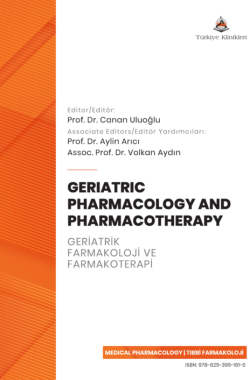Pharmacoepidemiological Studies in Geriatric Population
Sinem Ezgi GÜLMEZa
aKoç University Faculty of Medicine, Department of Medical Pharmacology, İstanbul, Türkiye
Gülmez SE. Pharmacoepidemiological studies in geriatric population. In: Uluoğlu C, ed. Geriatric Pharmacology and Pharmacotherapy. 1st ed. Ankara: Türkiye Klinikleri; 2023. p.60-3.
ABSTRACT
Pharmacoepidemiology is ”the study of the utilization, effects and adverse effects of drugs that are authorised by health authorities in large populations and made available for human health, in a manner that aims to further improve the principles of rational drug use and cost-effectiveness, thereby further improving health-related outcomes”. This drug-oriented definition has been recently updated to Real-World Evidence (RWE), as the use of drugs, biological products and medical devices, and the investigation of their side effects in real life conditions in very large populations, and the definition is still being updated. It is estimated that the geriatric population will reach approximately to 1 billion by 2032. Multiple drug use due to multiple co-morbidities, increased adverse drug reactions and hospitalizations are the main problems related to drug utilization in geriatric population. Special populations are not included in randomized clinical trials to keep the cohort as homogeneous as possible. This results in limited information on the use of new drugs in the geriatric population after marketing. In this context, the importance and priority of pharmacoepidemiological studies that can be performed on large populations using very specific databases and records without any intervention regarding drug use are increasing. More geriatric pharmacoepidemiological studies should be conducted for the safe use of drugs in geriatric population.
Keywords: Pharmacoepidemiology; geriatrics; drug utilization; observational study; database; electronic health records; safety
Kaynak Göster
Referanslar
- International Society for Pharmacoepidemiology (ISPE). [Available from: [Link]
- Montastruc JL, Benevent J, Montastruc F, Bagheri H, Despas F, Lapeyre-Mestre M, et al. What is pharmacoepidemiology? Definition, methods, interest and clinical applications. Therapie. 2018;74:169-74. [Crossref] [PubMed]
- Edlavitch SA, Tilson HH. For consideration by pharmacoepidemiologists. Pharmacoepidemiol Drug Saf. 2021;30(12):1619-20. [Crossref] [PubMed]
- ENCePP. The European Network of Centres for Pharmacoepidemiology and Pharmacovigilance (ENCePP) [Available from: [Link]
- Gini R, Fournie X, Dolk H, Kurz X, Verpillat P, Simondon F, et al. The ENCePP Code of Conduct: A best practise for scientific independence and transparency in noninterventional postauthorisation studies. Pharmacoepidemiol Drug Saf. 2019;28(4):422-33. [Crossref] [PubMed] [PMC]
- The European Network of Centres for Pharmacoepidemiology and Pharmacovigilance (ENCePP). Guide on Methodological Standards in Pharmacoepidemiology (Revision 5). EMA/95098/2010. 2010 [Available from: Available at [Link]
- ENCePP. ENCePP Guide on Methodological Standards in Pharmacoepidemiology. Annex 1 to the Guide on Methodological Standards in Pharmacoepidemiology. Guidance on conducting systematic reviews and meta-analyses of completed comparative pharmacoepidemiological studies of safety outcomes. 2015 [EMA/686352/2013:[Available from: [Link]
- Centers for Disease Control and Prevention. Trends in ageing - United States and worldwide. Morbidity and mortality weekly report. 2003 [Available from: [Link]
- Fried TR, O'Leary J, Towle V, Goldstein MK, Trentalange M, Martin DK. Health outcomes associated with polypharmacy in community-dwelling older adults: a systematic review. Journal of the American Geriatrics Society. 2014;62(12):2261-72. [Crossref] [PubMed] [PMC]
- Nessighaoui H, Geniaux H, Dantoine T, Laroche ML. [Medicines and frailty in older people. Towards a new nosological entity: A pharmacological frailty?]. Therapie. 2016;71(3):275-9. [Crossref] [PubMed]
- Montastruc JL. Les Cinq "trop" des essais cliniques : Plaidoyer pour une pharmacoépidémiologie pour tous. La Revue Prescrire. 2006;26(273):471.
- Tan ECK, Sluggett JK, Johnell K, Onder G, Elseviers M, Morin L, et al. Research Priorities for Optimizing Geriatric Pharmacotherapy: An International Consensus. Journal of the American Medical Directors Association. 2018;19(3):193-9. [Crossref] [PubMed]
- Schneeweiss S, Patrick AR, Sturmer T, Brookhart MA, Avorn J, Maclure M, et al. Increasing levels of restriction in pharmacoepidemiologic database studies of elderly and comparison with randomized trial results. Medical care. 2007;45(10 Supl 2):S131-42. [Crossref] [PubMed] [PMC]
- Onder G, Pedone C, Landi F, Cesari M, Della Vedova C, Bernabei R, et al. Adverse drug reactions as cause of hospital admissions: results from the Italian Group of Pharmacoepidemiology in the Elderly (GIFA). Journal of the American Geriatrics Society. 2002;50(12):1962-8. [Crossref] [PubMed]
- Furu K, Wettermark B, Andersen M, Martikainen JE, Almarsdottir AB, Sørensen HT. The Nordic countries as a cohort for pharmacoepidemiological research. Basic Clin Pharmacol Toxicol. 2010;106(2):86-94. [Crossref] [PubMed]
- Pukkala E, Engholm G, Højsgaard Schmidt LK, Storm H, Khan S, Lambe M, et al. Nordic Cancer Registries - an overview of their procedures and data comparability. Acta Oncol. 2018;57(4):440-455. Erratum in: Acta Oncol. 2018;57(4):565. [Crossref] [PubMed]
- Wettermark B, Zoëga H, Furu K, Korhonen M, Hallas J, Nørgaard M, et al. The Nordic prescription databases as a resource for pharmacoepidemiological research--a literature review. Pharmacoepidemiol Drug Saf. 2013;22(7):691-9. [Crossref] [PubMed]
- Martin-Latry K, Bégaud B. Pharmacoepidemiological research using French reimbursement databases: yes we can! Pharmacoepidemiol Drug Saf. 2010;19(3):256-65. [Crossref] [PubMed]

